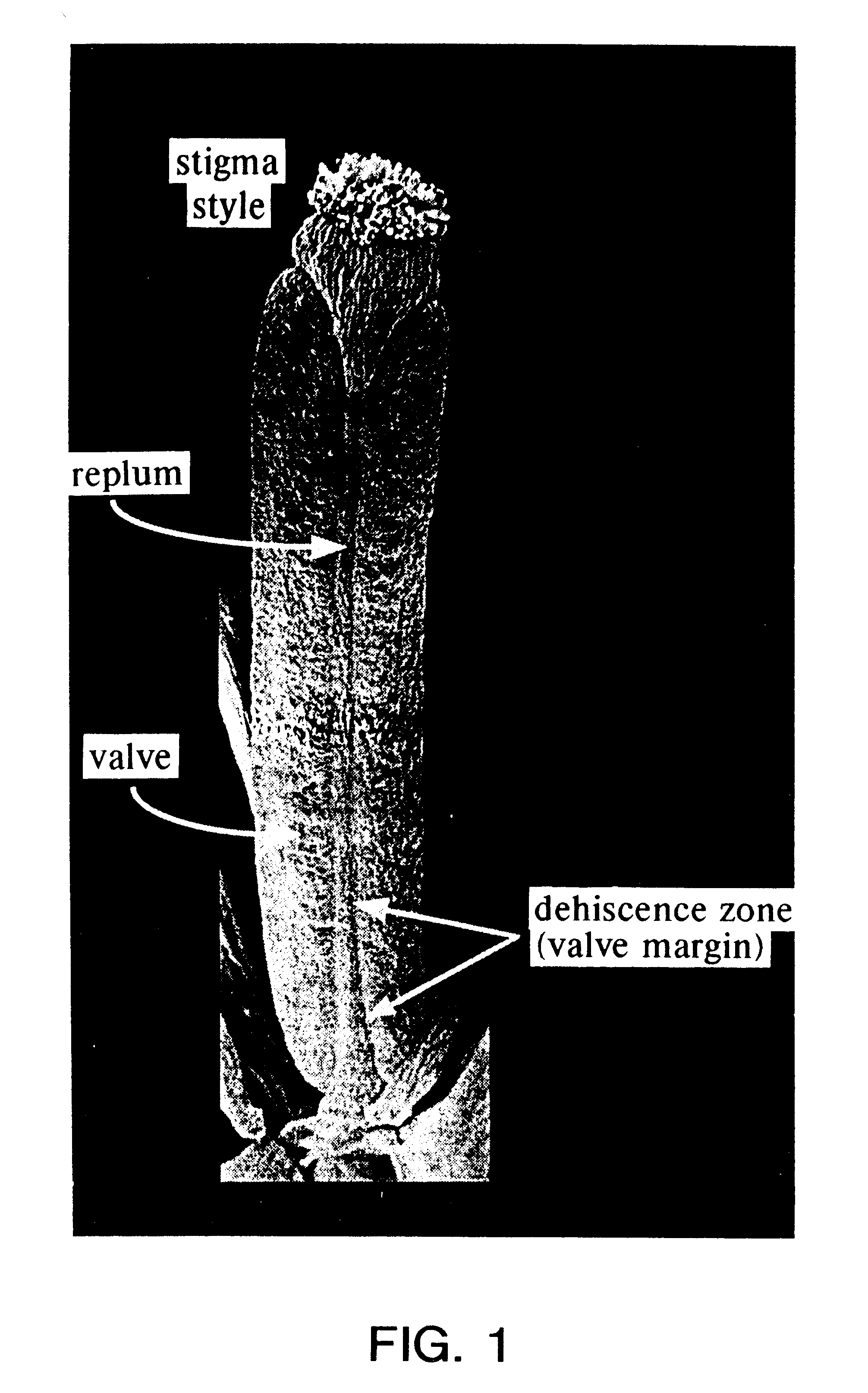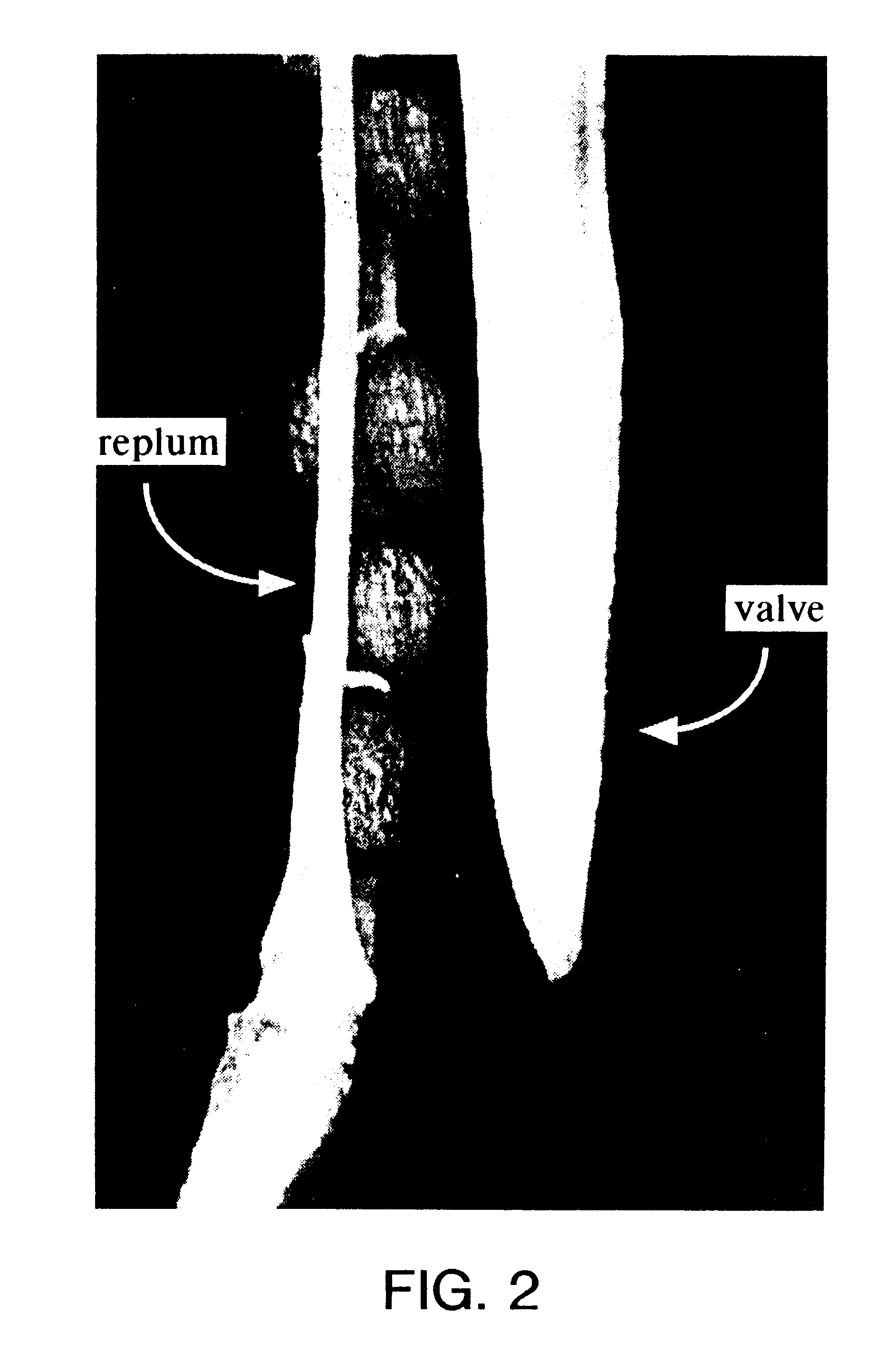Seed plants characterized by delayed seed dispersal
a seed plant and seed technology, applied in the field of plant molecular biology and genetic engineering, can solve the problems of reducing the yield of seed from rapeseed and related plants
- Summary
- Abstract
- Description
- Claims
- Application Information
AI Technical Summary
Problems solved by technology
Method used
Image
Examples
example ii
PRODUCTION OF AN ARABIDOPSIS agl1 agl5 double mutant DISPLAYING A COMPLETE LACK OF DEHISCENCE
This example describes the production of an agl1 agl5 double mutant displaying a complete lack of normal dehiscence.
A. Production of an agl5 mutant by homologous recombination
A PCR-based assay of transgenic plants was used to identify targeted insertions into AGL5 as described in Kempin et al., Nature 389:802-803 (1997), which is incorporated herein by reference. The targeting construct consisted of a kanamycin-resistance cassette that was inserted between approximately 3 kb and 2 kb segments representing the 5' and 3' regions of the AGL5 gene, respectively. A successfully targeted insertion produces a 1.6 kb deletion within the AGL5 gene such that the targeted allele encodes only the first 42 of 246 amino acid residues, and only 26 of the 56 amino acids comprising the DNA-binding MADS-domain. The recombination event also results in the insertion of the 2.5 kb kanamycin-resistance cassette w...
example iii
PRODUCTION OF A TRANSGENIC ARABIDOPSIS PLANT EXPRESSING AGL8 UNDER CONTROL OF THE AGL1 PROMOTER
This example demonstrates that a transgenic seed plant expressing AGL8 under control of a dehiscence zone-selective promoter is characterized by delayed seed dispersal.
AGL1::AGL8 transgenic plants Ectopic expression of AGL8 under control of the 35S promoter prevents pod shatter since the dehiscence zone fails to differentiate normally. However, constitutive AGL8 expression conferred by the 35S promoter also results in other changes, including early flowering. In order to specifically control dehiscence, AGL8 is expressed from a dehiscence zone-selective regulatory element, such as one derived from a regulated promoter that is normally expressed in valve margin, as described below.
An AGL8 expression construct under control of the dehiscence zone-selective 2.5 kb AGL1 promoter fragment and first AGL1 intronic sequence is prepared as follows. The 2.5 kb AGL1 promoter fragment is amplified by ...
example iv
AGL8 INTERACTS WITH AGL5 IN YEAST
This example demonstrates that, in a yeast two-hybrid system, the AGL8 gene product interacts with AGL5.
The "interaction trap" of Finley and Brent (Gene Probes: A Practical Approach (1994); see, also Gyuris et al., Cell 75:791-803 (1993)) is a variation of the yeast two-hybrid system of Fields and Song, Nature 10 340:245-246 (1989). In this system, a first protein is fused to a DNA-binding domain, and a second is fused to a transcriptional activation domain. An interaction between the Arabidopsis AGL5 and AGL8 gene products was assayed by activation of a lacZ reporter gene.
The "bait" and "prey" constructs were prepared in single copy centromere plasmids pBI-880 and pBI-771, respectively, which each contain the constitutive ADH1 promoter and are essentially as described by Chevray and Nathans, Proc. Natl. Acad. Sci. USA 89:5789-5793 (1992). The bait construct contains the GAL4 DNA-binding domain (amino acids 1 to 147) fused to the full-length AGL8 cod...
PUM
| Property | Measurement | Unit |
|---|---|---|
| time | aaaaa | aaaaa |
| lengths | aaaaa | aaaaa |
| genomic structure | aaaaa | aaaaa |
Abstract
Description
Claims
Application Information
 Login to View More
Login to View More - R&D
- Intellectual Property
- Life Sciences
- Materials
- Tech Scout
- Unparalleled Data Quality
- Higher Quality Content
- 60% Fewer Hallucinations
Browse by: Latest US Patents, China's latest patents, Technical Efficacy Thesaurus, Application Domain, Technology Topic, Popular Technical Reports.
© 2025 PatSnap. All rights reserved.Legal|Privacy policy|Modern Slavery Act Transparency Statement|Sitemap|About US| Contact US: help@patsnap.com



